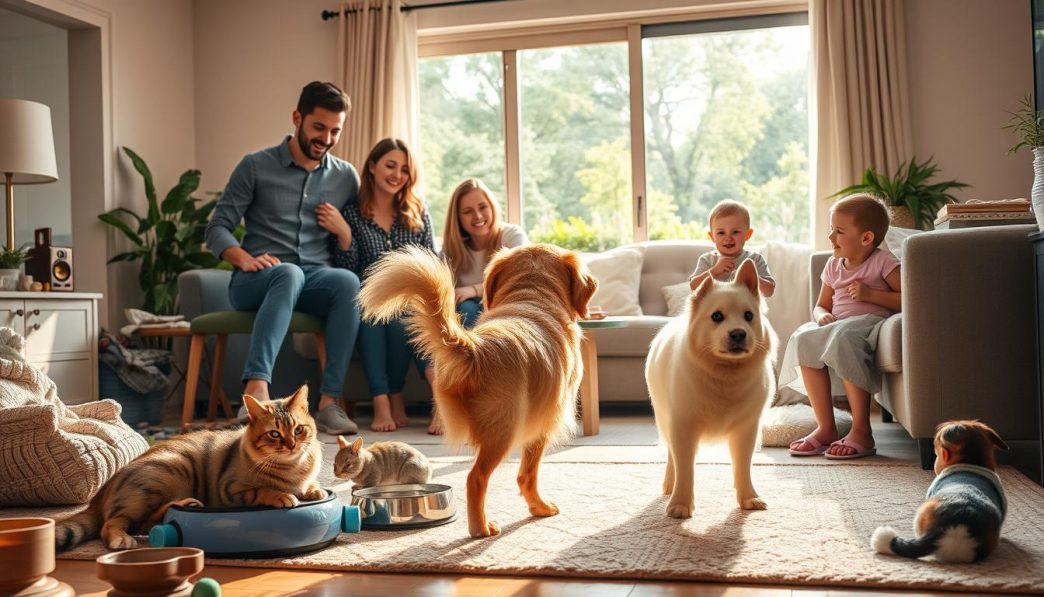More American homes than ever are filled with wagging tails and joyful purrs. Recent data shows an extraordinary shift, with over 70% of families choosing to share their lives with animal companions. This cultural transformation goes far beyond casual adoption—it’s rewriting how we live, work, and spend.
The American Pet Products Association reveals spending on animal care surged to $152 billion this year. What’s truly remarkable? This growth continues even during uncertain economic times. Families now prioritize their furry friends’ needs alongside human family members, from specialized diets to wellness plans.
Younger generations lead this movement, often welcoming multiple pets into their lives. Renters seek pet-friendly housing, while employers add paw-friendly policies. This isn’t a temporary phase either—experts confirm these patterns show lasting change in how people value their bonds with animals.
Key Takeaways
- 71% of U.S. families now include at least one animal companion
- Spending on animal care products hit record $152 billion in 2024
- Economic challenges haven’t slowed investment in pet wellness
- Housing and workplace trends increasingly accommodate animal needs
- Multi-pet households becoming common among younger Americans
- Human-animal bonds now influence major lifestyle decisions
Overview of the Expanding U.S. Pet Landscape
Animal companions now shape daily life across neighborhoods from coast to coast. Dogs maintain their top spot in 68 million homes, while cats charm their way into 49 million families. But today’s pet scene stretches far beyond these classics.
Emerging Ownership Trends and Key Statistics
Backyard chickens cluck their way into surprising relevance, with ownership jumping 28% since 2023. Over 11 million families now keep coops, blending practical food sources with feathery friendships. Other rising stars include:
- Freshwater fish tanks bubbling in 13.3 million homes
- Small mammal habitats doubling since 2020
- Reptile enthusiasts growing fastest in southwestern states
Insights from APPA’s Latest Data
The American Pet Products Association uses nationwide surveys and retail analytics to track this movement. Their methods reveal three key patterns:
- 77% of animal caregivers prioritize pets despite economic shifts
- Urban centers show highest cat adoption rates
- Suburban areas lead in multi-pet homes
One APPA researcher notes: “Our data doesn’t just count animals – it captures changing family values.” This cultural shift appears permanent, with 63% of new owners under 35 planning lifelong pet commitments.
Deep Dive: 94 Million Households Strong: How Pet Ownership Boom is Reshaping America
A quiet revolution is unfolding in American living rooms as furry friends claim their place in family life. Young adults lead this movement, transforming pet care from occasional responsibility to core household priority.

Growth in Household Pet Ownership Numbers
U.S. households welcoming animals jumped by 12 million since 2023. Three factors fueled this surge:
- Remote work flexibility enabling better pet care
- Increased focus on mental health benefits
- Expanding pet-friendly housing options
Gen Z accounts for 18.8 million pet-owning families – a 43.5% annual increase. This group now represents 1 in 5 dog and cat caregivers nationwide.
Role of Gen Z and Multi-Pet Dynamics
Seven out of ten young pet owners maintain multi-animal homes. “My three cats help me manage anxiety better than any app,” shares 24-year-old San Diego resident Mia Chen. This mindset drives unique trends:
| Generation | % of Pet Owners | Multi-Pet Homes |
|---|---|---|
| Gen Z | 20% | 70% |
| Millennials | 30% | 55% |
| Gen X | 25% | 48% |
| Boomers | 25% | 32% |
Social media amplifies this trend, with #PetParentLife videos garnering 14 billion TikTok views. Younger owners spend 28% more on veterinary care than older generations, prioritizing comprehensive wellness plans.
Generational Shifts and Emerging Consumer Trends
The face of animal companionship is evolving as younger demographics challenge traditional norms. Recent surveys reveal surprising shifts in who cares for furry family members and how they prioritize their needs.
Redefining Gender Roles in Animal Care
Male dog owners under 35 increased by 18.6% since 2023, with similar growth among cat owners. “My bulldog Bruce helps me unwind after coding sessions,” says 26-year-old software developer Ethan Reyes. “His anxiety vest works better than my meditation app.”

| Group | Calming Products (Dogs) | Calming Products (Cats) |
|---|---|---|
| Gen Z | 78% | 71% |
| Millennials | 72% | 66% |
Wellness-Focused Spending Patterns
Younger pet owners spend 31% more on preventive care than older generations. They seek:
- Vet-approved CBD treats
- GPS-enabled collars
- Hypoallergenic grooming kits
Ethical sourcing matters too—63% check sustainability certifications before buying food. This conscientious approach extends to housing choices, with 58% prioritizing pet-friendly rentals over square footage.
As one veterinary researcher notes: “We’re seeing human healthcare standards applied to animals.” From tailored meal plans to mental health support, today’s caregivers treat their companions as equal family members.
Economic Impact and Industry Expenditures in the Pet Market
Behind every wagging tail lies a multi-billion dollar economic engine. The pet industry hit $152 billion in spending this year, proving animal care now rivals tech and automotive sectors in market power. Experts project this figure will climb to $157 billion by 2025, showing remarkable resilience during shaky economic times.
Increasing Pet Care and Product Sales
Food and treats dominate budgets at $67.8 billion, but owners aren’t skimping on health needs. Veterinary services and related products will reach $41.4 billion next year – a 5.6% jump from 2024. “Families view pet wellness as non-negotiable,” notes an American Pet Products Association report. Even live animals and supplies contribute $34.3 billion as multi-pet homes multiply.
Omnichannel Retail and Digital Engagement
Shoppers blend convenience with hands-on care:
| Purchase Type | Online % | In-Store % |
|---|---|---|
| Food & Treats | 63% | 37% |
| Toys & Accessories | 58% | 42% |
| Medications | 41% | 59% |
Apps now handle 28% of vet appointments, while smart feeders account for 19% of recent product sales increases. This digital shift helps explain the industry’s 114% growth since 2010.
Future Projections Amid Economic Uncertainty
While treats and toys might see slower sales during downturns, essential care remains steady. The pet products association forecasts sustained growth through 2026, driven by Gen Z’s spending habits and tech innovations. As one analyst puts it: “This market doesn’t just survive challenges – it adapts and thrives.”
Conclusion
The bond between Americans and their animal friends now influences everything from urban planning to corporate policies. This cultural shift continues to redefine modern life, with younger generations integrating pets into career choices and living arrangements. Nearly 40% of caregivers report challenges accessing affordable veterinary services, highlighting growing pains in this expanding market.
Workplaces adapt remarkably fast – pet-friendly policies increased 17% since 2023, with HR leaders calling these perks “essential for talent retention.” Meanwhile, the $152 billion pet industry shows no signs of slowing, projected to reach $157 billion by 2025.
New norms emerge as cat and dog owners demand better care options and employers rethink office dynamics. While challenges exist, the data paints a hopeful picture: animal companionship remains central to American identity. From apartment leases to boardroom meetings, our four-legged family members continue shaping a more compassionate society.






